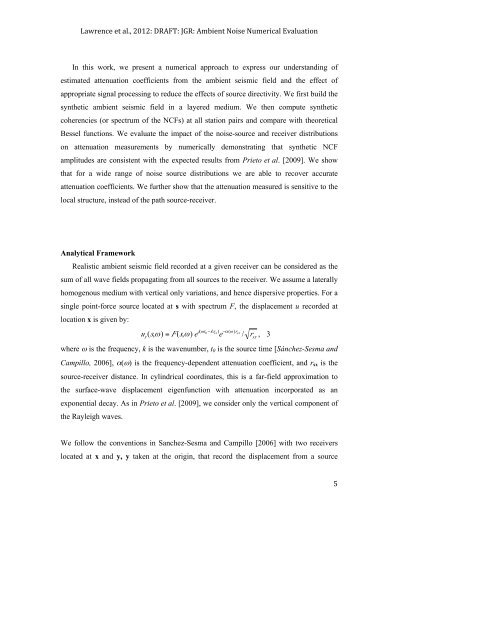Lawrence et al., 2012: DRAFT: JGR: Ambient Noise Numerical ...
Lawrence et al., 2012: DRAFT: JGR: Ambient Noise Numerical ...
Lawrence et al., 2012: DRAFT: JGR: Ambient Noise Numerical ...
Create successful ePaper yourself
Turn your PDF publications into a flip-book with our unique Google optimized e-Paper software.
<strong>Lawrence</strong> <strong>et</strong> <strong>al</strong>., <strong>2012</strong>: <strong>DRAFT</strong>: <strong>JGR</strong>: <strong>Ambient</strong> <strong>Noise</strong> Numeric<strong>al</strong> Ev<strong>al</strong>uation<br />
In this work, we present a numeric<strong>al</strong> approach to express our understanding of<br />
estimated attenuation coefficients from the ambient seismic field and the effect of<br />
appropriate sign<strong>al</strong> processing to reduce the effects of source directivity. We first build the<br />
synth<strong>et</strong>ic ambient seismic field in a layered medium. We then compute synth<strong>et</strong>ic<br />
coherencies (or spectrum of the NCFs) at <strong>al</strong>l station pairs and compare with theor<strong>et</strong>ic<strong>al</strong><br />
Bessel functions. We ev<strong>al</strong>uate the impact of the noise-source and receiver distributions<br />
on attenuation measurements by numeric<strong>al</strong>ly demonstrating that synth<strong>et</strong>ic NCF<br />
amplitudes are consistent with the expected results from Pri<strong>et</strong>o <strong>et</strong> <strong>al</strong>. [2009]. We show<br />
that for a wide range of noise source distributions we are able to recover accurate<br />
attenuation coefficients. We further show that the attenuation measured is sensitive to the<br />
loc<strong>al</strong> structure, instead of the path source-receiver.<br />
An<strong>al</strong>ytic<strong>al</strong> Framework<br />
Re<strong>al</strong>istic ambient seismic field recorded at a given receiver can be considered as the<br />
sum of <strong>al</strong>l wave fields propagating from <strong>al</strong>l sources to the receiver. We assume a later<strong>al</strong>ly<br />
homogenous medium with vertic<strong>al</strong> only variations, and hence dispersive properties. For a<br />
single point-force source located at s with spectrum F, the displacement u recorded at<br />
location x is given by:<br />
where ω is the frequency, k is the wavenumber, t0 is the source time [Sánchez-Sesma and<br />
Campillo, 2006], α(ω) is the frequency-dependent attenuation coefficient, and rsx is the<br />
source-receiver distance. In cylindric<strong>al</strong> coordinates, this is a far-field approximation to<br />
the surface-wave displacement eigenfunction with attenuation incorporated as an<br />
exponenti<strong>al</strong> decay. As in Pri<strong>et</strong>o <strong>et</strong> <strong>al</strong>. [2009], we consider only the vertic<strong>al</strong> component of<br />
the Rayleigh waves.<br />
We follow the conventions in Sanchez-Sesma and Campillo [2006] with two receivers<br />
located at x and y, y taken at the origin, that record the displacement from a source<br />
, 3<br />
5
















